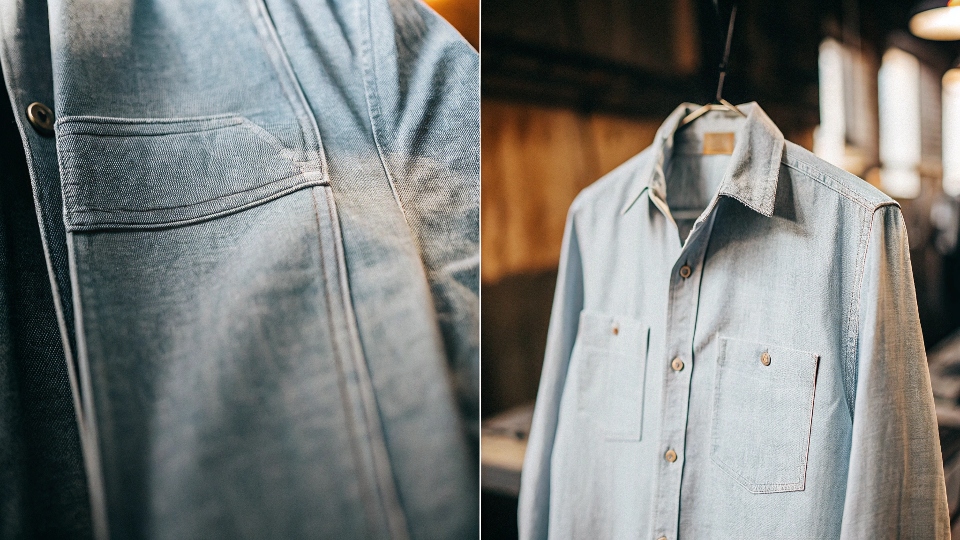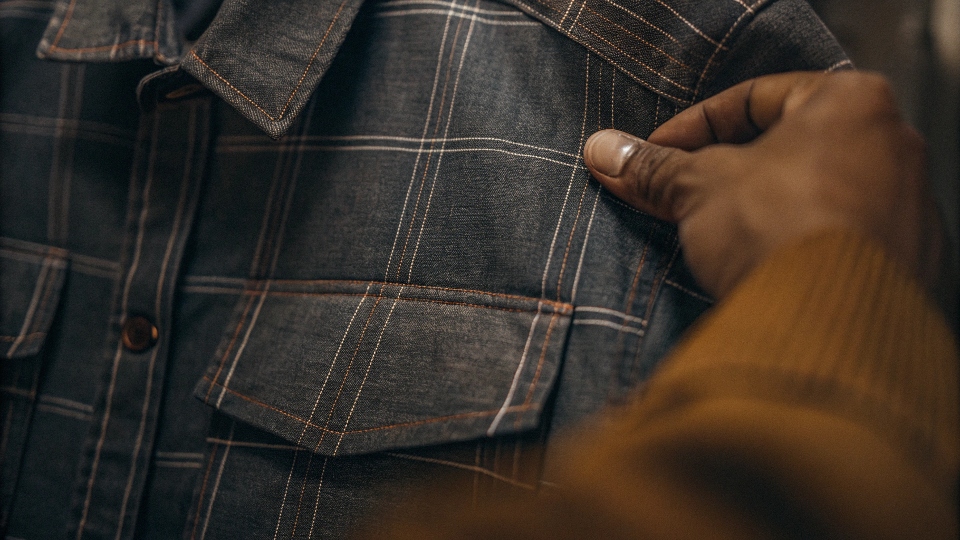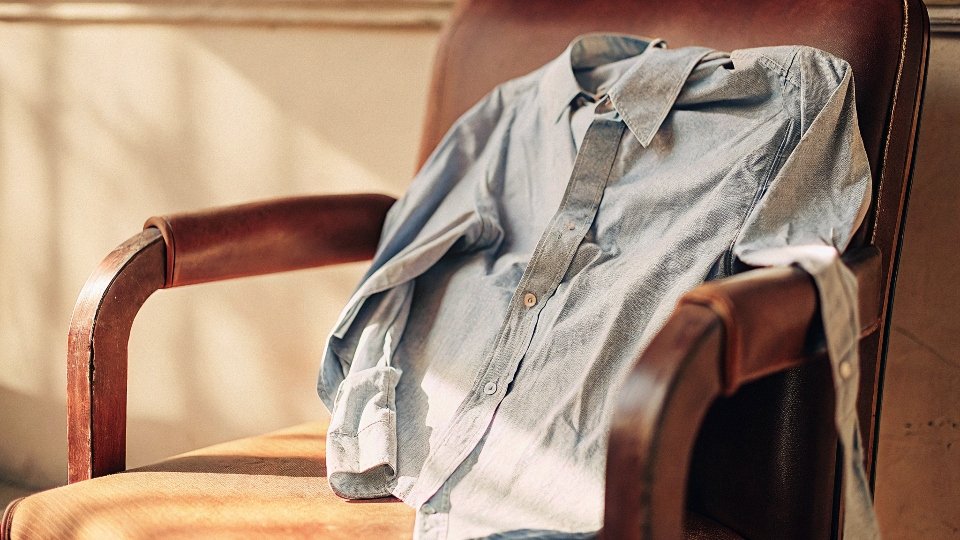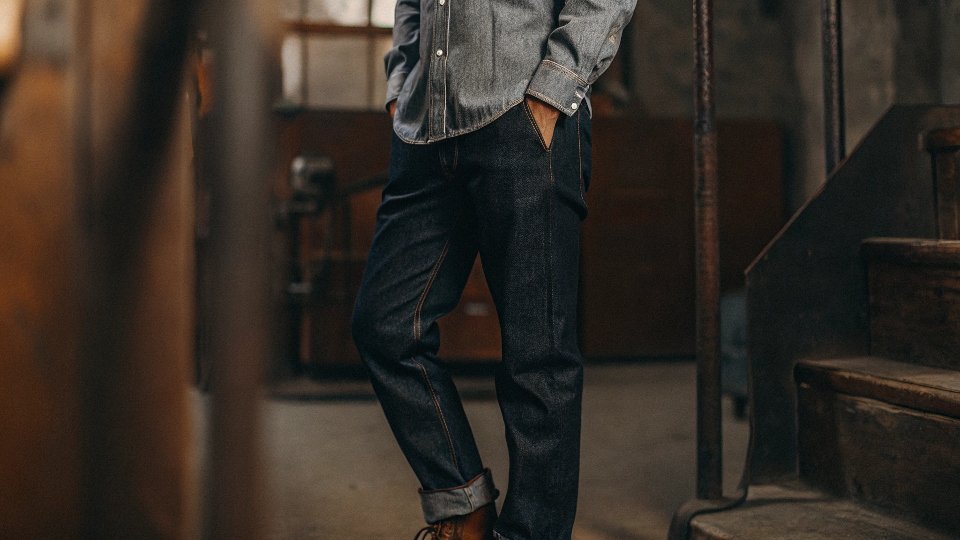You see two blue shirts that look almost identical. But one feels soft and light, while the other is tough and heavy, leaving you confused about what you are actually buying.
The main difference is the weave. Denim has a diagonal twill weave, making it heavy and durable. Chambray has a simple plain weave, which makes it lighter, softer, and more breathable, with a smoother finish.
In my 20 years at the helm of DiZNEW, this is one of the most common questions I get. Even seasoned designers like Dean will specify "a blue workshirt," and my first question is always, "Denim or chambray?"
They look similar from a distance, but in the world of fabric, they are fundamentally different. Understanding this difference is not just trivia; it is key to choosing the right garment for comfort, style, and durability. Let's look closer at what sets them apart.
Is a chambray shirt the same as a denim shirt?
You think a chambray shirt is just a trendy name for a lightweight denim shirt. But when you wear them, they feel completely different, and you suspect there's more to the story.
No, they are absolutely not the same. Denim is made with a strong twill weave that creates a diagonal pattern. Chambray uses a basic plain weave, like a bedsheet, resulting in a much lighter and softer fabric.
The core difference comes down to how the threads are put together. My essential insight on this is simple: imagine a colored (usually blue) "warp" thread running lengthwise and a white "weft" thread running crosswise. In chambray, the threads interlace in a simple, one-over, one-under pattern. This is called a plain weave.
For denim, the blue warp thread floats over two or more white weft threads before going under one. This creates a diagonal (twill) weave. This structural difference changes everything. The plain weave of chambray makes the fabric breathable and gives it a smooth, flat surface.
The twill weave of denim packs the threads more densely, making the fabric much stronger, heavier, and giving it that signature diagonal texture you can see and feel.
| Feature | Chambray | Denim |
|---|---|---|
| Weave Type | Plain Weave (one-over, one-under)1 | Twill Weave (over two, under one)2 |
| Appearance | Smooth, flat, linen-like | Textured with visible diagonal lines |
| Weight | Lightweight and airy | Mid-to-heavyweight |
| Feel | Soft and breathable | Stiff (at first) and rugged |
How to tell denim from chambray?
You're trying to choose between two shirts, but the tags just say "100% Cotton." You need a quick way to tell the difference so you can pick the right one.
Look at the fabric up close. Denim has visible diagonal lines, while chambray has a simple grid pattern. Denim also feels thicker and is much lighter on the inside than it is on the outside.
After handling these fabrics for decades, I can tell them apart with my eyes closed. Here are three simple tests anyone can use to become an expert.
1. The Visual Test
Get your eyes close to the fabric. Look for a pattern in the weave. If you can see distinct diagonal lines or ribs running across the surface, it is denim. That's the twill weave. If the surface looks flat and has a simple criss-cross grid, like a standard cotton bedsheet, it is chambray3.
2. The Touch Test
Feel the weight and texture in your hands. Chambray is light, soft, and smooth. It drapes easily and feels comfortable against the skin immediately. Denim is heavier, stiffer, and has a much coarser, more rugged texture. It feels like a fabric meant for work.
3. The Reverse Test
This is the most definitive test. Flip the fabric over and look at the color on the back. Because of denim4's twill weave, where the blue warp threads dominate the front, the white weft threads are more visible on the back.
This makes the inside of a denim shirt significantly lighter than the outside. Chambray's plain weave distributes the colored and white threads more evenly, so its color is nearly identical on both sides.
What are the disadvantages of chambray fabric?
You chose a chambray shirt for its amazing comfort and light weight. However, you notice it gets wrinkled right after washing and you worry it won't hold up over time.
Chambray's primary disadvantages are its lack of durability compared to denim and its high tendency to wrinkle. Its lightweight construction makes it less suitable for rugged use and means it requires more frequent ironing.
While chambray is fantastic for warm weather and refined looks, it's important to understand its limitations. At my factory, we choose fabrics based on the final garment's purpose, and chambray has clear trade-offs.
Its biggest weakness is durability5. The same plain weave that makes it breathable also makes it less resistant to snags, abrasion, and tearing compared to the tightly woven structure of denim. It's a shirt for the office or a casual weekend, not for demanding physical work.
Another significant downside is how easily it wrinkles.Like other lightweight dress shirt fabrics, it creases with wear and comes out of the wash looking crumpled. Denim, with its heavier weight and structure, resists wrinkles6 far more effectively. For a designer like Dean, this means chambray is a poor choice for a structured piece. It's meant to drape softly, not to hold a crisp shape.
Can I wear a chambray shirt with jeans?
You have a perfect chambray shirt and your favorite jeans. You want to wear them together, but you are terrified of committing the fashion crime known as the "Canadian tuxedo."
Yes, you can and should wear a chambray shirt with jeans. It’s a classic look. The secret to success is to create a clear contrast in shade and texture between the shirt and the pants.
This is a timeless combination that works because the two fabrics are, as we've discussed, inherently different. The dreaded "Canadian tuxedo7" happens when the denim top and bottom are too similar in color and wash, creating a strange, uniform-like appearance.
Here is how to do it right. The number one rule is contrast. Pair a light blue chambray shirt with dark, raw denim jeans. Or, wear a darker indigo chambray shirt with a pair of faded, light-wash jeans. The difference in shade is what makes it look intentional and stylish. Secondly, you already have a built-in textural contrast.
The smooth, flat surface of the chambray shirt naturally stands out against the textured, diagonal weave of the jeans. This visual difference is key. Finally, you can use accessories to create separation. A simple brown or black leather belt is often enough to break up the blues and complete the look.
Conclusion
The difference between denim and chambray is simple: denim's twill weave is for durability, while chambray's plain weave is for soft, lightweight comfort. Choosing correctly is key to great style.
-
Understanding plain weave is essential for appreciating fabric textures and their applications in fashion. ↩
-
Exploring twill weave will enhance your knowledge of fabric durability and design, crucial for textile enthusiasts. ↩
-
Discover the versatility of chambray and its applications in fashion and home textiles. ↩
-
Explore this link to understand denim's unique properties and how it differs from other fabrics. ↩
-
Understanding chambray's durability can help you make informed choices for your wardrobe and fabric selection. ↩
-
Exploring this comparison will provide insights into fabric care and maintenance for your clothing. ↩
-
Understanding the Canadian tuxedo can help you avoid fashion faux pas and elevate your style. ↩











